The Tesseract appeared over our skies six days ago, an alien artifact intent on removing our planet from existence. The cube has shrunk and can now fit in the palm of one’s hand. Can you disarm and contain the Tesseract to save the world?
Game Overview
Tesseract is a cooperative dice manipulation game designed by James Firnhaber and published by Smirk & Laughter Games. While an abstract puzzle, Tesseract has a science fiction theme that really shines with its components and artwork.
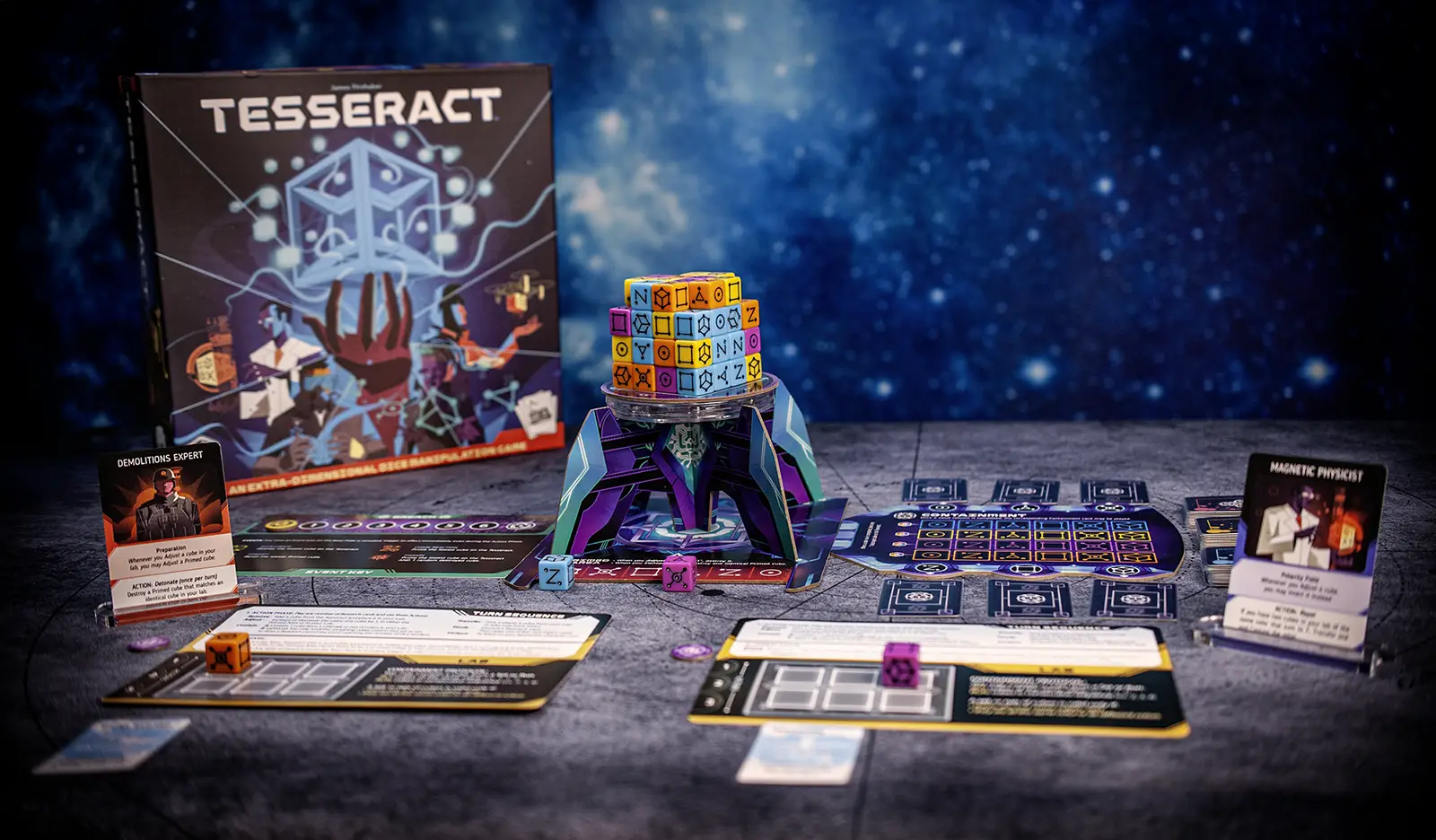
Components
The main component for Tesseract is the custom dice. The retail version comes with beautiful, easy-to-read plastic dice. Metal dice are an optional upgrade that I purchased and are simply stunning. Both sets of dice feature custom numbers – count the pips to determine their value. This gives them a high-tech appearance. Whichever set of dice you use, there are 64 total – 16 of each of the 4 colors.

You’ll assemble these dice as a 4x4x4 “Tesseract” dice cube sitting upon a base plate with a lazy Susan. Underneath are Base Platform Legs, and you’ll set this on the Platform board, which doubles as the Primed Area.

There are 4 double-sided base plates that vary in difficulty. Below you can see four base plate examples.
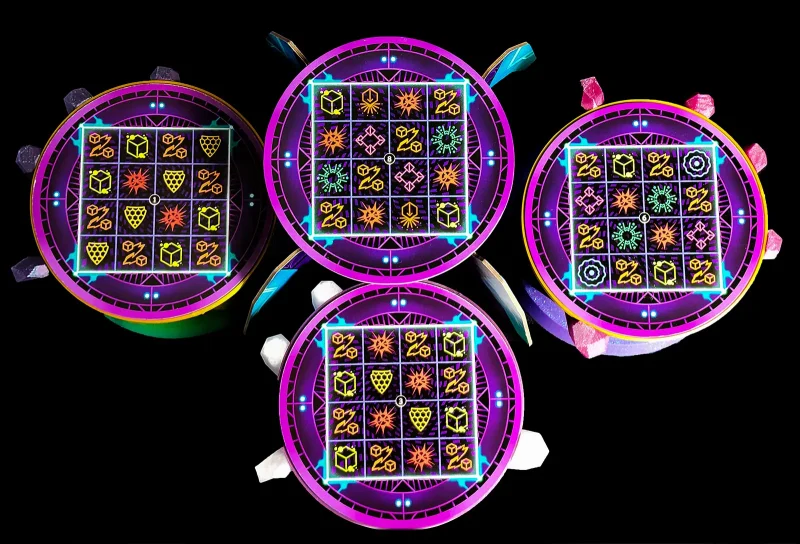
As you remove cubes from the Tesseract, after removing 4 cubes from one column, you’ll uncover an Event icon on the base plate.

Refer to the Breach Mat and trigger that effect immediately. The revealed icon in the image above shows the “Accelerate” Event. This Breach Mat is double-sided, the front side showing only the four most common icons in the left column below.
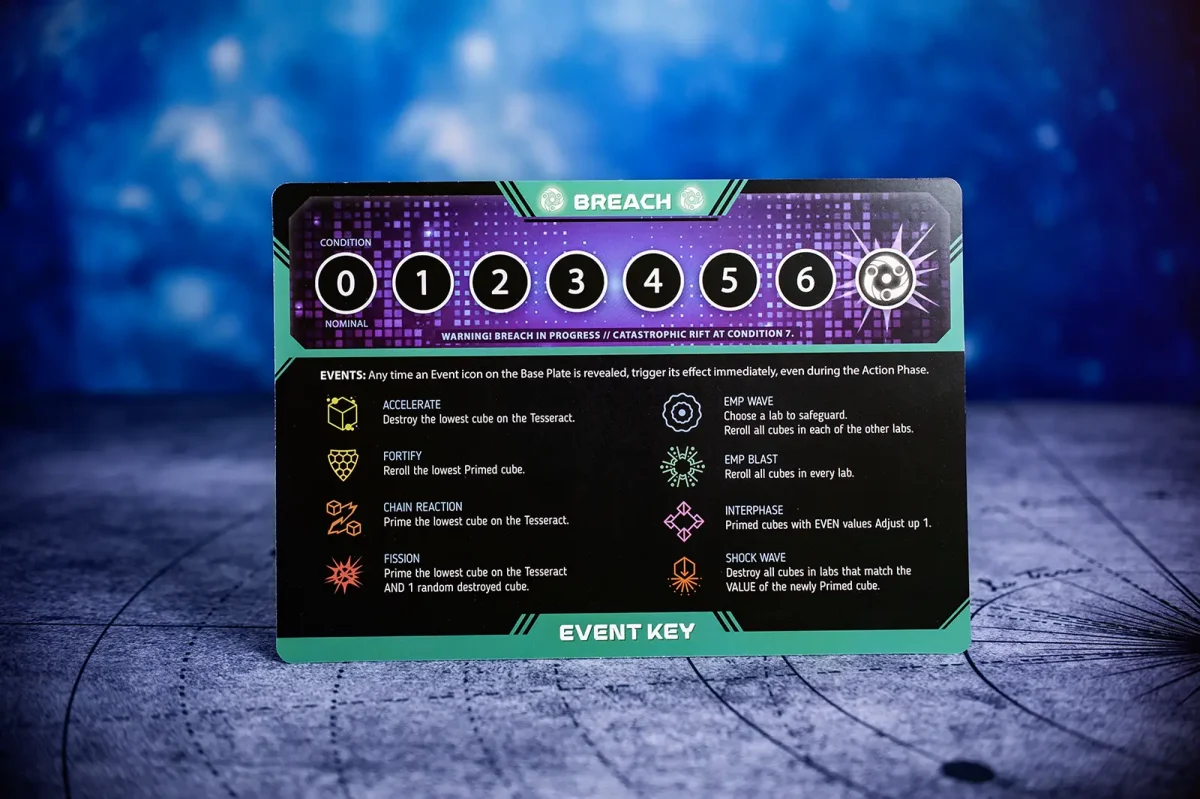
The game comes with a cube sleeve that will form the dice in a cube as you slowly pour the dice inside.
There are 11 Standard-sized Researcher Character cards. As a solo player, you’ll play two Researchers. Each has a passive, “always-on” ability and a Unique Action ability that you can use for one of your three actions per turn.

There are 50 Mini American-sized Containment and Research cards that you can earn throughout the game that grant useful abilities. Six Containment cards will be placed around the Containment board. Research cards come in Levels 2, 3 and 4 that you’ll earn mostly through creating Sets and Runs of cubes and containing a cube in that set. You’ll earn Containment bonuses as you contain cubes. All six colors in a row will allow you to return a Destroyed die to the Tesseract, buying you more time. Completing a column of four of the same value dice will grant a powerful one-time Containment card ability that any character may use.
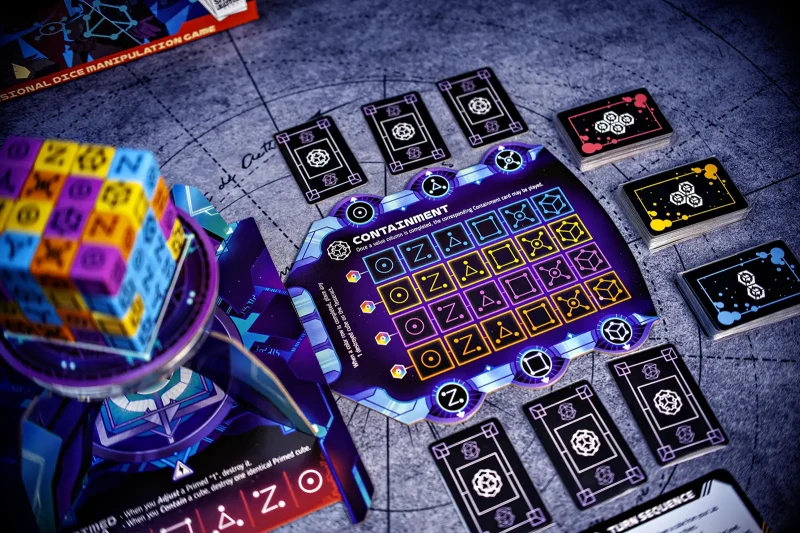
As for the box and component artwork, the design is eye-catching and attractive. The box is suitable for its size. Unfortunately, the plastic insert leaves no room for two sets of dice or sleeved cards, so I threw away the insert.
Objective
To win, contain (collect) 1 die of each color and value, filling all 24 spaces on the Containment board.
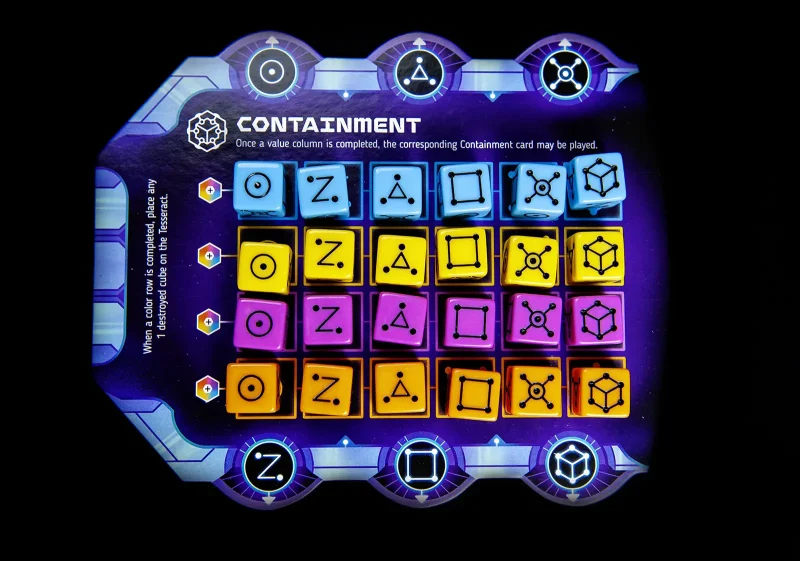
There are 6 values and 4 colors of dice. With 64 dice and 16 dice of each color, you can afford to “destroy” up to 10 dice of each color.
There are two ways to lose:
- If the last cube is removed from the Tesseract.
- If there are 7 Breaches.

Basic Mechanics

Set Collection
To win, you’ll need to collect all 6 values of all 4 colors of the dice and “Contain” them. To achieve this, you’ll need to collect Sets or Runs of dice in your Player Lab. A Set is dice (cubes) of the same value. A Run is dice in consecutive sequence values. Sets and Runs are valid only if there are at least 3 cubes and they are all either the same color or all different colors.


Dice Manipulation
There are various ways to manipulate the dice to complete your sets. A basic action is “Adjust,” where you can increase or decrease the value of a cube by 1. You may have a unique ability to “Invert” a die and turn it over to its other side.
Containment and Research cards will also allow you to manipulate the dice – in the Primed Area, your Lab and on the Tesseract.

The gameplay consists of two main phases per turn – Action and Threat Phases.
Action Phase – Active Researcher takes 3 actions (listed below) in any order. You may also play any number of Research cards before, during or after your turn.
- Remove: Take a removable cube from the Tesseract and place it into your Lab.
- Adjust: Change the value of a cube in your Lab or the Primed Area, up or down by one.
- Transfer: Move a cube from one Lab to another.
- Study: Swap a Research card for one of the next higher levels.
- Contain: Place one cube from a Set or Run onto the Containment board.
- Unique: The unique action of your Research card.
The Player Board shows the Turn Sequence and lists the Actions and Threats, which can be handy initially, although I’d prefer that Player Aid cards be used instead. I caught onto the rules in my first game and never referred to the Player Board. The bright background of the aid is a bit distracting for me, and I feel less immersed. Instead, I put my Researcher card and other cards on it.
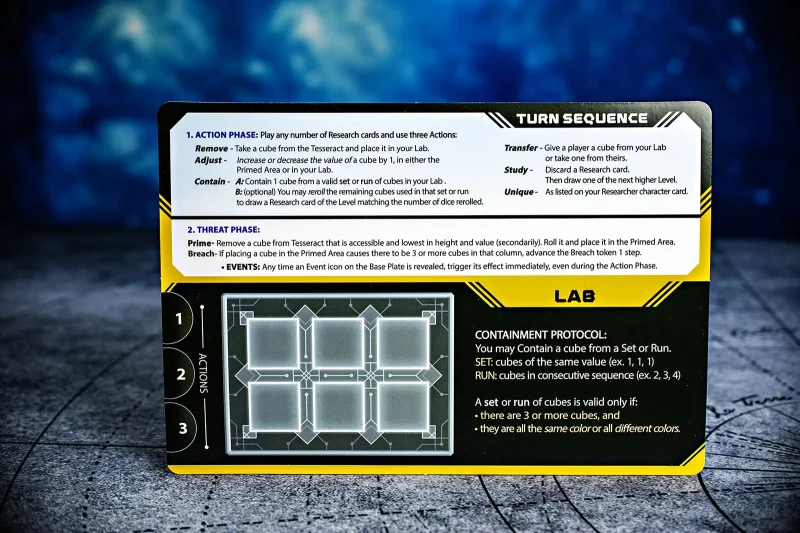
Threat Phase
- Prime – Remove a cube on the Tesseract that is lowest in height and value. Roll it and place it in the matching Primed Area according to its value.
- Breach – If placing a cube in the Primed Area causes 3 or more cubes in that value column, advance the Breach token one step. (The image below shows a breach on the 3 value.)
- Events – If a Threat icon on the base plate is revealed by Priming a cube, trigger its effect.
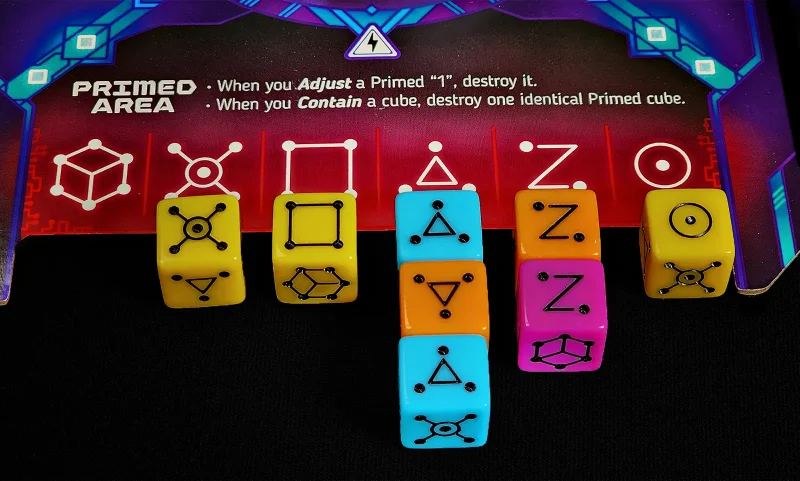
Solo Gameplay Experience
Solo mode
To play Solo, play two-handed with two Researchers. Being a cooperative game with open information, there is no difference between solo and multiplayer modes. Many of the Researchers’ abilities were meant to work optimally with another researcher, which is an important reason why the solo play requires two researchers.
Personal Solo Experience
I’ve only played Tesseract solo so far. I found the solo gameplay smooth and easy to work with the two Researchers. I enjoy making the most of their unique abilities and using different strategies in each game based on the two Researcher characters. As I improve, I try the next card a level up.
I do think I’d enjoy playing multi-player as well!
Tips
- Watch out when the Primed Area accumulates 2 Primes of the same value. It can easily lead to a breach!
- After a Containment, opting for a Research card and rolling the remaining cube set is usually the best idea. These cards offer free actions; you can “Study” and upgrade them to more powerful actions.
- Don’t forget your Containment bonuses!
Footprint
The solo game setup with two characters is approximately 30 inches wide and 20 inches deep, making it fit comfortably in a Medium footprint.
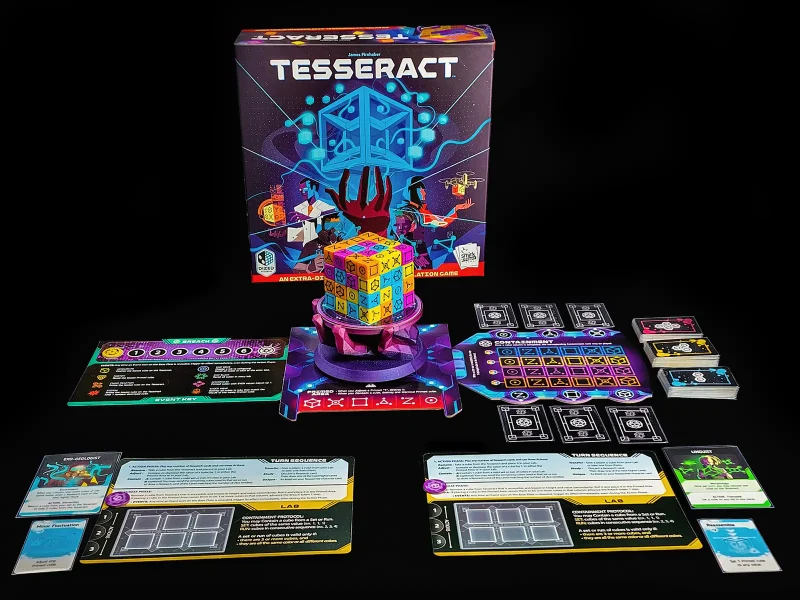
Time to Play
My first dozen solo plays took 35-90 minutes, with an average playtime of one hour. A Fresh Setup takes about 3 minutes. A Repeat setup will take 2-3 minutes. Assembling the Tesseract cube looks daunting, but with the sleeve and some shaking, all cubes will fall into place easily. Teardown is just two minutes, throw all the dice in a bag, no need to organize them.
Tesseract Bling
I admit the shiny dice attracted me to purchase this game on the spot last month. After it arrived, I realized the retail game comes with plastic dice, but I found the Rare Element Deluxe Kit online and got the 64 Anodized Metal dice and matching Containment board. While the plastic dice are perfectly fine and easier to read, the metal dice have a great look and feel that I could not resist.
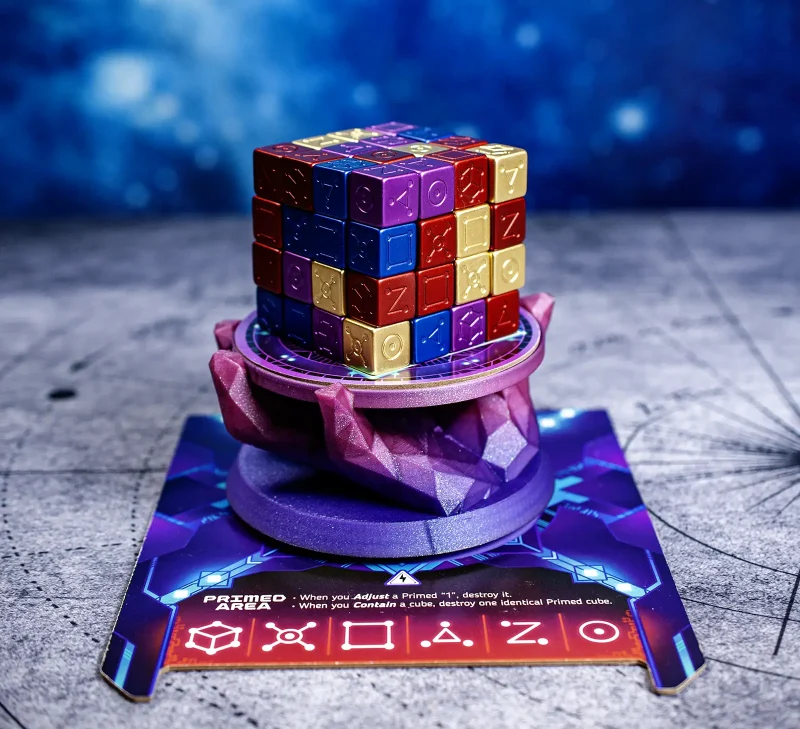
I learned about the 3D-printed hand file while watching one of the Dice Tower videos. It has two .stl files – the hand and the disc. The game’s lazy Susan fits perfectly under the hand base.

I chose a sparkly color-changing filament, and it fits the theme perfectly! I actually printed out three sets.
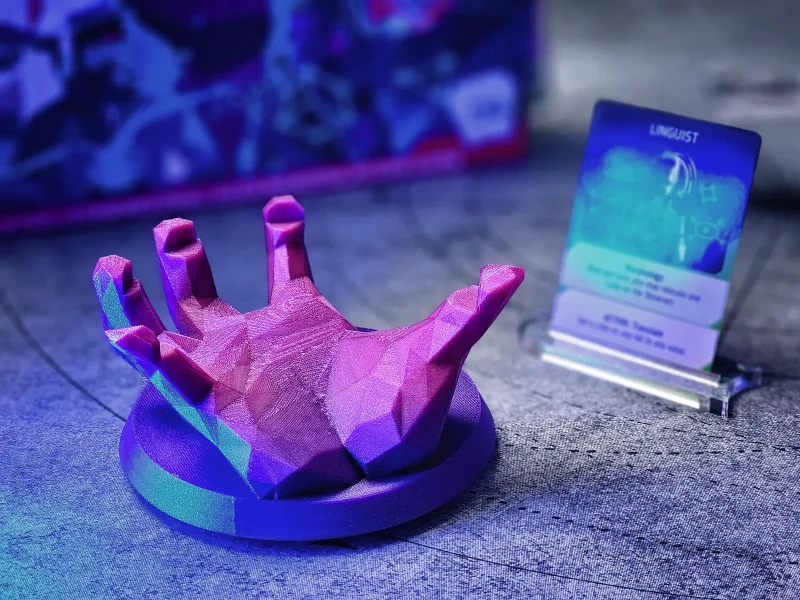
Replay Value
I love that the game comes with 11 different Researcher cards. Playing solo, you’ll have the abilities of two different Researchers, and many of their abilities are synergistic. In some cooperative games like Pandemic, I feel compelled to include the same Scientist in my games, but for Tesseract, I absolutely don’t mind shuffling the cards and working with what I get.
Below one of my Researchers was an Exo-Geologist, so I had both Researchers helping this character gain 4 cubes of the same value. Due to the passive ability Enrichment, I was able to draw the best Level 4 Research cards, which can really be a game changer.

I played this game 14 times so far. After playing a few games, the first Base Plate offered no challenge, so I’m working through all of them and am on #5 now. There are 8 different Base Plates with increasing difficulty.
If you need to increase the difficulty further, you can start the game with no Research cards and/or Priming more cubes at setup.

Tesseract Pros and Cons
Pros
- It’s a fun puzzle that’s quick to learn.
- Adjustable difficulty and asymmetric Researcher roles offer replayability.
- Amazing Table presence!
- Spinning the dice cube is a fun but effective gimmick.
Cons
- Although it wasn’t an issue for me, dice may fall off the Tesseract when spinning or selecting a die. Just be careful and spin slowly.
- The game may be hard to find at the moment, but the game has a second printing available for Spring 2024.
- You either win or lose. Perhaps adding a score would offer more incentive for replayability. I offer a simple scoring solution below.

Scoring Idea
To add extra incentive to play the game and improve, I started scoring my games.
Add the base plate number plus the number of dice remaining in the Tesseract. Subtract the number of breaches incurred for the game. Share your score!
Using this scoring idea, my latest (and best) score is 20. Played on a Level 6 Base Plate, had 16 cubes remaining on the Tesseract, and 2 Breaches. My previous score was 13 – Level 5, 11 cubes left, 3 breaches.
Final Thoughts for Tesseract
This was a wonderfully pleasant solo puzzle that I am enjoying! I don’t have many negatives for this game, as I love puzzles, and this one is also aesthetically dazzling. I’m very happy I made this spur-of-the-moment purchase last month. The Kickstarter was fulfilled in September 2023, so it’s a relatively new game. Copies are scarce now. The good news is that a second printing should arrive soon!
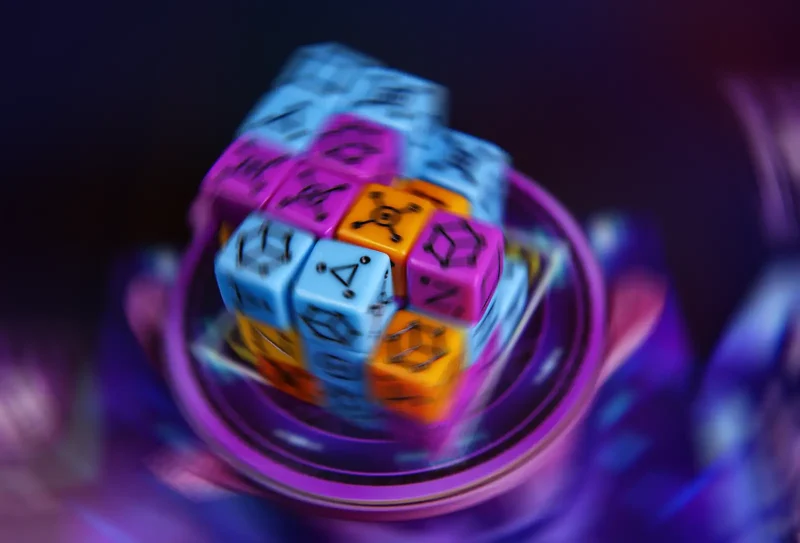
How About You?
Do you own the game? What do you think of the scoring idea? If you don’t own Tesseract, what are your favorite solo dice manipulation games that you’d recommend?

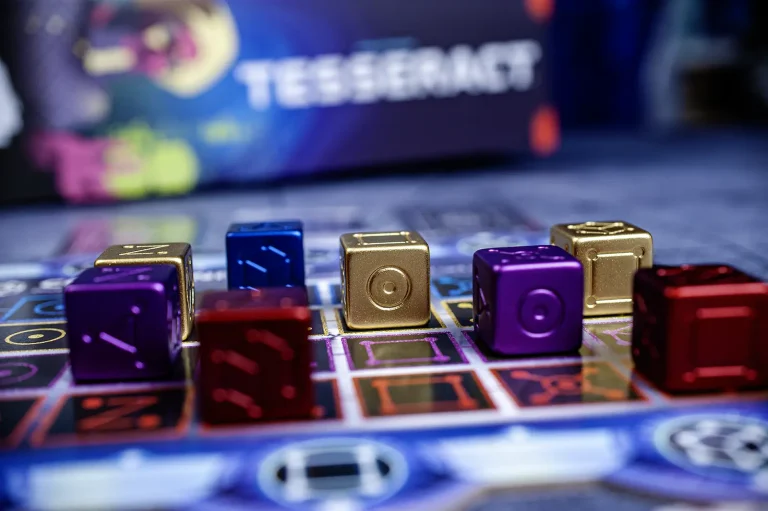


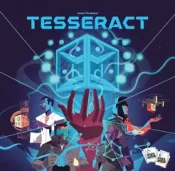
Leave a Reply